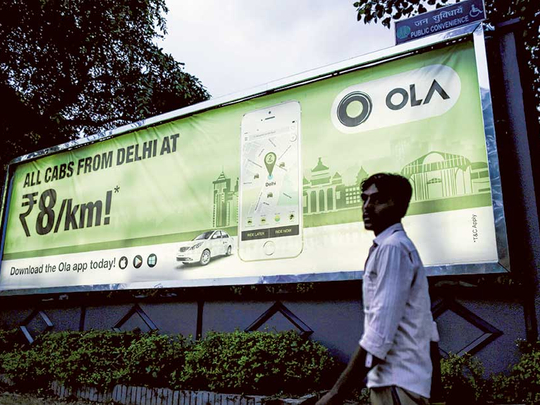
Bhavish Aggarwal, co-founder of the ride-hailing service Ola, is in a pitched battle with Uber Technologies Inc. for domination of India’s streets. But late last year, the streets of Chennai disappeared as monsoon rains flooded miles of the southeastern port city.
Aggarwal quickly commandeered scores of boats from wherever he could find them. He helped with government rescue efforts, picking up passengers in fishing trawlers, canoes and inflatable rafts. The stranded cheered his ingenuity and contribution to the recovery. Ola 1, Uber 0.
Aggarwal is counting on that kind of local touch to repel the intrusion of Uber, the world’s most valuable start-up. The San Francisco-based company, led by billionaire Travis Kalanick, said last year it will spend about $1 billion in India and it has gained ground against the incumbent.
Ola is part of an alliance of ride-hailing companies in China, Singapore and the US that have teamed up to challenge Uber with their knowledge of domestic markets, customers and governments.
“We understand the Indian context so much better,” said the 30-year-old at the start-up’s headquarters in Bengaluru. “Uber conquered a market where people had cars in their garages. In India, we didn’t have garages, we didn’t have cars, we didn’t even have roads.”
Uber showed off its clout earlier this month by attracting the largest single venture investment ever, $3.5 billion that came from Saudi Arabia’s sovereign wealth fund and valued the start-up at $62.5 billion. Ola is undersized by comparison. Its valuation is $5 billion and it has raised less money in its entire existence than Uber did in the last funding round.
“Scrappiness only gets you so far,” said Anand Sanwal, CEO of research firm CB Insights. “Uber with the war chest it has can subsidise drivers and even riders. That makes a big difference.”
Aggarwal contends Ola has a better grasp of how to operate in a country with infrastructure challenges like nowhere else. India’s public transportation systems are often overwhelmed by the country’s 1.3 billion people and traffic jams can last hours.
“Money is not the thing that wins the market. It is experience,” he said. “When I see people hanging out of packed buses, perched atop jam-packed local trains, a family of four astride a motorcycle, I realise how much still lies ahead.”
In the interview, Aggarwal is affable and boyish, open to answering almost any question. But when the conversation turns to Uber and Kalanick, he can’t quite conceal his animosity. He’s partly agitated a foreign rival is trying to lay claim to such a promising business. He also thinks Uber’s tactics go beyond acceptable, including a lawsuit over alleged fake bookings.
“We didn’t start the fire,” he said.
Aggarwal won acceptance into the elite Indian Institute of Technology in Mumbai, where he studied engineering. After a brief stint at Microsoft Corp., he left to start his own venture. He and classmate Ankit Bhati tried selling holiday trips online, but customers were scarce.
In 2011, they shifted to offering car rentals in Mumbai, based out of a 100 square foot office in the basement of a half-empty shopping Centre called Dreamz Mall. “When asked where our office was, we’d say ‘Dreamz Mall’,” recalled Bhati, now chief technology officer. “People invariably asked, ‘Dream Small?” ‘
What they lacked in flash, the duo made up for in sweat. Bhati coded all day to create the website. Aggarwal worked around the clock answering phone calls and riding the jammed Mumbai trains to pitch customers.
In 2012, they began offering rides on demand, at first only to customers who called in their requests. When drivers didn’t show up, Aggarwal borrowed a car from his girlfriend, now his wife, to pick up the client. “Even today I get ‘Book me a cab’ calls on that number,” he said.
Later that year, they introduced a smartphone app so customers could summon a ride without making a phone call. The business began to take off and they landed a $5 million investment from Tiger Global Management, giving them cash to grow.
Then Uber entered India in 2013. Aggarwal knew he had to scramble or lose his head start. The company had less than half a million dollars in the bank and he spent all the cash on expansion. Aggarwal maxed out his credit cards to keep things on track.
His credit score is still terrible. “We were tiny when Uber came to India, the challenge only drove us to get more ambitious,” said Aggarwal.
Still, it quickly became clear Uber had a lot to learn about the local market. The American company required people to pay with credit cards, like in the US, even though most Indians only use cash. Its app was only available in English, while Ola offered its service in eight other languages.
Aggarwal’s hard work began to pay off as he added customers and especially drivers, essential for a service that depends on giving people a lift at a moment’s notice. Rangaswamy H.K, a Bengaluru-based driver, uses Ola’s Kannada language version and prefers the domestic start-up.
“Ola understands drivers well,” said Rangaswamy, who gets paid each day unlike Uber drivers who are paid weekly. “It is nice to see the accounts done and have my day’s earnings in my own bank account.”
In 2014, Aggarwal found a solution to his cash crunch. Ola got backing from Silicon Valley’s Sequoia Capital and Japan’s SoftBank Group Corp. In 2015, he splurged on an acquisition of local ride-summoning rival Taxi For Sure.
Aggarwal also stepped up his emphasis on localisation, drawing on his own experiences from not owning a car and navigating the gridlocked streets near his office. Ola was the first to start a call Centre for drivers. The company also introduced more vehicle choices: motorcycles, three-wheel autorickshaws and cab options at multiple price points, including BMW, Mercedes and Jaguar sedans.
In its premium category, Ola offers Wi-Fi so riders can use their time productively. It also lets customers book trips ahead of time, a “ride later” feature that Uber just unveiled in the US this month.
Ola has expanded quickly and is now in 102 cities, compared with Uber’s 27. No independent agency measures marketshare and the two companies spar fiercely over the proper figures. Uber claims to handle 50 per cent of the trips in its 27 cities “as per internal estimates,” a spokeswoman said.
Ola said its market share in those cities is over 75 per cent, according to “third party” measures it has collected. “It is a brutally competitive market,” said Mohandas Pai, a tech investor and former board member at Infosys Ltd. “Right now, Ola has an edge.”
Neeti Nayak, a spokeswoman for Uber, said the company has adapted quickly to the India market, instituting cash payment options, setting up a call Centre for drivers and offering a variety of vehicles. The app is still available solely in English in India, a hurdle for many drivers who are literate only in local languages.
Meera Keshav, a Bengaluru-based chartered accountant, has been using Ola since it began in the city. “Ola has more cabs on the street so I can find a car quickly,” she said.
Ola’s alliance partners — Didi Chuxing in China, Grab in Southeast Asia and Lyft in the US — focus on adapting for local markets too, said Aggarwal.
“All of us founders are good friends, we believe that local is better than global, we talk all the time and share business know-how,” he said.
The alliance threatens to stymie Uber as it works to justify its dizzying valuation. Kalanick is spending heavily in China to draw customers, but his company has struggled against Didi, which has been able to raise plenty of money itself, including $1 billion from Apple Inc.
The battle in India, Uber’s third-largest market, is less capital intensive, but subsidies for drivers and customers are still common. Ola, which raised $900 million last year, may well have to seek additional money to fend off Uber. “I suspect they’re going to need more funding,” said Sanwal of CB Insights.
In his sun-filled offices overlooking Bengaluru’s chaotic streets, Aggarwal sees dramatic change ahead for his industry. He predicts self-driving cars will be a reality in five to 10 years and sees electric vehicles gaining widespread adoption as battery prices fall.
The founder, who still works at least 12 hours a day, sticks rigorously to the schedule on his calendar and the time allotted for his interview is almost over. But near the end of the session, he relays with a mischievous smile that Ola has started in his hometown of Ludhiana, where transportation was such a headache when he was a child.
The entry set off a family drama: The driver for Aggarwal’s parents quit, bought his own car and registered for Ola. His mother was upset — at first. Then she downloaded her son’s app and learnt to summon a car whenever she wanted one. “She feels liberated,” he said.












